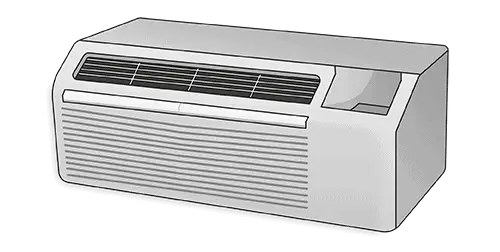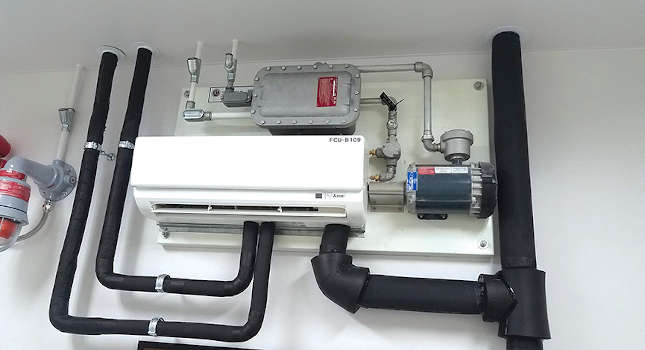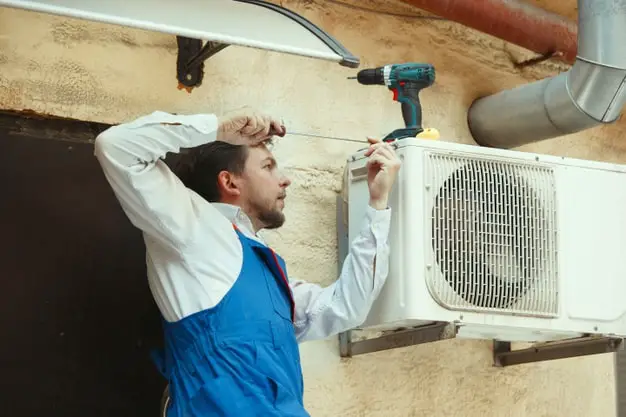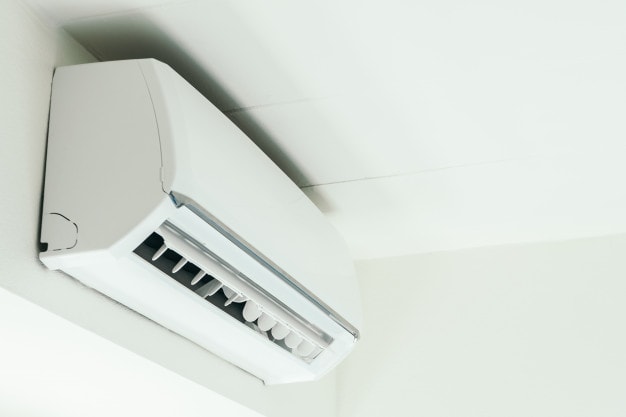While it can be slightly worrying, the cost of replacing your air conditioning unit might not be as financially intimidating as you fear it might.
The average air conditioning unit costs around $4500 to replace but depending on the size of the unit in your home, it could cost less or it might cost more. The price of a replacement unit isn’t just determined by size though, and that’s why we’ve put this guide together, to break down everything that you need to know about replacing your AC unit and how much it’s going to cost you if you do have to invest in a new system

Factors that Affect the Cost Replacing Your AC Unit
While it may seem like a relatively straightforward job, swapping one air conditioning unit for another, there are a number of factors (including the cost of the unit itself) that will form part of the cost of having your AC unit replaced.
The AC Unit - BTU Rating and Size
Four things affect the cost of an AC Unit. The first of these is its BTU (British Thermal Unit) rating, which governs the amount of air, and the area, that the AC unit can effectively cool. The higher the BTU rating, the more square footage it can cool. For example, an eighteen thousand BTU unit provides around one and a half tons of cooling power and costs on average around $2,000 for the unit by itself. For a much larger unit, say a sixty thousand BTU model that has five tons of cooling capacity, the cost rises to $3,700.
Efficiency Rating
How efficient a unit also plays a significant role in determining its costs and installation. Measured by a SEER (Seasonal Energy Efficiency Rating) figure, the higher the SEER number is, the more efficient an AC Unit is. The lowest SEER rated units usually carry a figure between thirteen and fourteen and are designed to be as efficient as they can be and usually cost around $2900.
If you want a more efficient AC Unit, a middle ground system that has a SEER rating of eighteen (which means that it’s highly efficient) costs around $4700, while the highest-rated SEER units, which are commonly called Maximum Efficiency Models and have a SEER number between twenty-two and twenty-four usually have a price tag of $6,800.



Single, Two-Stage and Variable Speed AC Units
If you want an additional amount of control that can determine the level of cooling that your unit is capable of providing, it might be worth pursuing this AC option. A single-stage AC unit will run at one hundred percent cooling power where it’s switched on, a two-stage will vary the amount of heat it draws from the air and cools, and a variable speed unit will give you complete control over your AC unit.
However, as costs vary from unit to unit and from brand to brand, and replacing your current AC unit with a variable speed model can mean replacing your furnace or other additional work to your home, you should always speak to a professional about this option before making any firm decisions about an upgrade.
Brands
The last of the cost factors that apply to the cost of the unit itself is the brand. Some brands cost more than others, and we’ll discuss this in more detail later on. The costs of the AC unit itself should be around forty percent of your total outlay.
Permits and Inspection
Any installation of an AC Unit needs a permit and an inspection to ensure that the work being done is up to the national HVAC (Heating, Ventilation, and Air Conditioning) code and any additional regulation your state of residence has put in place. As both usually cost $100-$200 depending on your zip code and area regulations, they’ll usually be around five percent of your total outlay for the job.



Photo credit: csemag.com
Indoor Coil and Refrigeration Line Costs
When AC units are replaced, more often than not you’ll also need to replace the indoor coil and refrigeration lines that are part of the system. This should amount to roughly ten percent of the total costs of the installation of the new AC unit. It won’t run without either of them - remember the bigger the unit that you’re having installed, the bigger your cooling coil will need to be, and the more refrigeration line you’ll need to use.
Labor
The bigger your replacement unit is, the bigger the job will be and as you’ll be using a professionally qualified HVAC installation engineer, labor won’t be cheap. Depending on the size of your replacement unit, labor can cost anything from $1200-$2,500 and usually accounts for 30% of the final amount that you’ll pay for the job.
How Much Does it Cost to Replace an AC Unit?
Now that you know all the factors that you’ll need to take into consideration when replacing your AC unit, it’s time to actually find out, or at least come up with a real-world figure that’ll give you a fairly accurate idea of, how much it’s going to cost to do the job.
The AC Unit
The first stage of the process, before you start looking at new units, is finding out what size of AC unit you’re going to need. It’s a fairly easy calculation, but you’ll need to know the square footage of your home to ascertain the size of the AC unit that you’ll need to replace your current model. We’ve already talked about the BTU figures and how many tons of cooling power they produce, but the simplest way to find out what size BTU unit you’ll need is with a little easy math.
For every four hundred square feet of space that your home occupies, you’ll need your new AC unit to produce one ton or twelve thousand BTUs of cooling power. So, dependent on the size of your home, your new AC unit (before installation) could cost anywhere between $2,000-$4,000, depending on the size of the area that you need to keep cool.
AC Unit Efficiency Ratings
Remember we discussed the SEER (Seasonal Energy Efficiency Rating) earlier? This has a big impact on not only the installation costs (the higher the SEER rating, the more it will cost you to install is the general rule of thumb) but the overall running costs of your AC unit.
The lower the SEER rating is on an AC unit, the less efficient it is to run and the more it’ll cost you to keep it on when temperatures start to climb. While an AC unit with a SEER rating of fourteen would be fine in upstate New York, the bill for running the same AC unit somewhere much warmer like Florida or Texas would be crippling. The warmer the area you live in is, the higher you’re going to need the SEER rating on your AC unit to be.



While an AC unit for a one thousand square foot home in Pennsylvania (which would need a twenty-four thousand BTU AC Unit with a Seer rating of fourteen), with installation, might cost $3,500, in Texas to achieve the same level of cooling form the same size unit and not have it send your energy bills skyrocketing, it would cost around $5,900 as your AC unit would need to be much more efficient and, have a much higher SEER number to cope with the Texas heat. The simple fact of the matter is, where you live has a much greater impact on the cost of your replacement AC unit than almost anything else.
Coil Size and Refrigeration Lines
The bigger the AC unit that you’re replacing, the larger the size of indoor coils and the more refrigeration line - the bigger the unit, the more coolant your AC unit will need, and the more coolant it needs, the more line you’re going to need to be installed. The cost of both is dependent on the size of the unit that’s replacing your old one.
Replacement and Installation
It might cost more, but it’s better to be safe than sorry, which is why you should only use an HVAC certified installer or engineer to replace your AC unit. Costs for replacement can run anywhere between $1,000 and $3,000 and the more complex and involving a job is, the more it will cost.



There are additional issues that might increase the costs such as the availability of the installer (this can be affected by seasonal demand, as sadly most AC units fail during the Summer, which ironically is when they’re needed the most, meaning that replacing your AC during those months is far more expensive than it would usually be) extra wiring, new ductwork and certification can all play a part in the cost of replacing your AC unit. It’s better to get as many quotes as you possibly can, and a detailed breakdown of what you’re going charged for, before entering into any contractual obligation.
Average Air Conditioner Installation Costs
While the total cost of replacement can, and does vary according to the size of the home that the unit is being installed in, on average the cost for a complete AC unit replacement is $7,000. In larger suburban properties it can cost anywhere up to $12,000 for the entire air conditioning system to be replaced and in smaller residential properties, the cost can be as low as $4,500.
As we’ve already mentioned, the costs are entirely dependent on the size and complexity of the system being installed, but for the average family home, an entirely new replacement air conditioning system shouldn’t cost more than $8,000.



Photo Credit: HomeGuide.com
Average Cost of AC Units by Brand
With a seemingly never-ending list of manufacturers, it’s hard to know which one to choose and which AC unit brand is best suited to your home. So we thought we’d point you in the direction of our top five AC manufacturers.
American Standard
One of the most well known and well-respected names in the HVAC industry, all of American Standard’s AC units come with a twelve-year guarantee and their AC units start at an incredibly reasonable $1350.
Goodman
A top brand of choice of suburban America, Goodman is a budget and bank balance friendly brand that doesn’t believe that lower pieces should mean lower quality and the five models of AC unit that they make provide enough versatility and adaptability to cater to the needs of anyone looking for a replacement AC unit. Prices start at $985 and are geared toward the sort of budget that the average American household can easily afford.



Photo credit: HomeGuide.com
Amana
With a reputation for combining cast iron warranties with quality and a solution for every possible AC problem, Amana’s units start at $1300 and increase in price according to the efficiency and size demands of their customers.
Carrier
The manufacturer noted for spoiling its customers with choice, Carrier produces three separate lines of AC units that include a total of sixteen different models. And while the aforementioned sixteen models vary greatly in performance and price, they start at an incredibly modest $1500.
York
A company with a simple motto, “It’s time to get comfortable”, York is noted for producing the quietest AC models on the market. So if you like things to be turned down, but you still appreciate the luxury of a good AC unit, when you do need to replace yours, you can rest secure in the knowledge that York’s incredibly reliable units start at just $1500.
Average AC Unit Cost By Type
Even though you’re undoubtedly familiar with and probably have a central air conditioner unit (that works in conjunction with a home’s heating system to keep the entire house cool when it’s in use), there are other types of air conditioning units that you might want to consider in future.
Split Air Conditioning Systems
Also known as a mini-split system, this is a ductless air conditioning system that uses inside and outside AC units to maintain a steady and comfortable temperature inside your home and prices usually start at around $2,000.



Air Conditioning Window Units
Easy to install and use, they’re designed to keep one room of a house cool during the months when the temperature escalates and climbs beyond a point that’s bearable and to keep the heat inside when it starts to plummet again. A much affordable solution to home air conditioning, they start at around $150.



Portable Air Conditioners
These small units are based on an evaporative HVAC design that, according to the individual machine, uses either a split or hose system to adjust the temperature of the room that they’re being used to cool. An effective and portable solution that’s been engineered to provide air conditioning for every budget, they can provide a barrage of cold air for as little as $40.



Tips Getting the Best Deal on an Air Conditioner Replacement
Replacing an AC unit can be expensive, so it’s always prudent and wise to shop around for the best deal that you can find. Sometimes state and local utility companies offer incentives and deals on replacement AC units and systems, so it’s always worth seeing if they’re running one that you can take advantage of and use to ease the financial burden that you’ll be facing.
It’s also worth remembering that sometimes, the system that’s already in use in your home might not be the right size, and might be costing you extra, and working overtime to try and cool down a much larger property than it was designed to. Do the quick calculation for the square footage of your home compared to the BTU output and size that you actually need. You might be surprised by the result.
And talking of efficiency, it’s also worth taking a look at a new system that has a high SEER rating, as even though it might cost you a little more to install upfront, it can, and will save you money in the long run by vastly reducing your energy bills.
Last, but by no means least, and probably the easiest way to save money on replacing your AC is by following the golden rule of any contracting job - never run with the first quote. Get as many different quotes as you can and talk to each of the HVAC installers at length, again, it’s surprising what taking the time to talk to someone can achieve and it could reduce your installation costs.



Conclusion
Hopefully, you’ll now know everything that you need to in order to replace your AC unit at a price that you can afford. Remember to factor in all of the costs that you’ll need to cover, as there’s more to AC unit replacement than just having the unit installed, and don’t forget to work out what size unit you’ll need for your home and to consider the energy efficiency implications and what a more efficient AC unit could mean for your bank balance in the long run. And with that, you’re ready and prepared to find your new AC unit.
Frequently Asked Questions
Here are some popular questions that we have answered:
Do Expensive AC Units Last Longer?
As nearly every AC unit is designed to last at least ten to fifteen years and usually comes with a warranty that covers that period, unfortunately, they don’t. They might cost more and have more features built-in, but in the long run, they’ll last as long as the cheaper AC unit does. All you have to do is make sure that the unit installed in your home is the right size, and whatever it costs, it should last for the period specified by the manufacturer.
How Long Do Air Conditioners Last?
On average, as we’ve already mentioned, AC (air conditioning) units last between ten and fifteen years, but if they’re maintained and regularly checked and serviced by a qualified HVAC technician, they can last far longer. Most manufacturers are happy to guarantee their systems for at least ten years and supply them with warranties that cover them for the first decade of their life.



Can I Install My AC Myself to Reduce the Costs?
While there seems to be a difference of opinion regarding whether you can or can’t replace your AC unit yourself, the simple truth of the matter is that you can’t.
Even though it might seem like a sure-fire way to save money, the only way to ensure that your AC unit is installed safely and will operate as it should is by having it fitted by a qualified and certified HVAC technician.
Under no circumstances (unless you’re HVAC qualified) should you even attempt to install your own AC.
Should I Repair or Replace My AC Unit?
It’s always better, and most of the time far cheaper, to try to have your AC repaired rather than replaced. If the fault has occurred in the first ten years of its working life, it’ll probably be covered by the warranty, and most AC faults can be easily fixed. That said, if it has lived a long and productive life that has far exceeded its lifespan, then it might be time to replace your AC unit.
Do I Have to Replace My Furnace When I Replace My AC?
No, you don’t have to replace your furnace when you replace your AC. It’s true that both of them are linked and work together, but just because one breaks down it doesn’t mean that the other needs to be replaced too. The only time that you might have to think about replacing your furnace at the same time as your AC unit is if your furnace is more than ten years old. And even then, don’t just do it, get an expert opinion first.
How Can I Extend the Life of My AC Unit?
The only way to do it by making sure that it’s regularly inspected and maintained by a qualified HVAC technician. If any part needs to be replaced, replace it and any part needs to be fixed, have it fixed. It’s the only way to make sure that your AC unit lives a long and prosperous life and never lets you down when you need it the most.
Related AC Cost Guides
Here are some related guides we have that you may be interested in:
